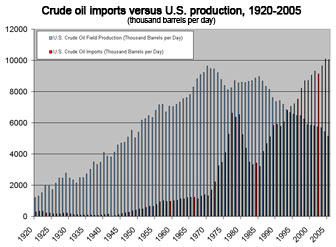President Obama has moved to allow states set automobile emission rules, opening the door for more fuel efficient vehicles.
Monday Obama signed a memorandum requiring the Environmental Protection Agency (EPA) to reconsider California’s application to set tighter auto emissions and fuel efficiency [Corporate Average Fuel Economy – CAFE) standards than required under federal law. Should the waiver be granted, automakers would be forced to sell more fuel efficient vehicles if they want to do business in the state.

The race for the title of “Largest carbon dioxide emitter” pits the United States versus China. The United States had a large head start but China is expected to surpass it in emissions this year or next.
|
13 other states are said to be considering similar rules.
“Increasing fuel efficiency in our cars and trucks is one of the most important steps that we can take to break our cycle of dependence on foreign oil,” said Obama during a press conference announcing the move. “It will also help spark the innovation needed to ensure that our auto industry keeps pace with competitors around the world.”
Obama said he will work towards implementing new fuel standards for the 2011 model year.
His remarks follow.
Obama’s Remarks on Jobs, Energy Independence, and Climate Change from the East Room of the White House on January 26, 2009
Good morning. Before I begin today’s announcement, I want to say a few words about the deepening economic crisis that we’ve inherited and the need for urgent action.
Over the last few days we’ve learned that Microsoft, Intel, United Airlines, Home Depot, Sprint Nextel, and Caterpillar are each cutting thousands of jobs. These are not just numbers on a page. As with the millions of jobs lost in 2008, these are working men and women whose families have been disrupted and whose dreams have been put on hold.
We owe it to each of them and to every, single American to act with a sense of urgency and common purpose. We can’t afford distractions and we cannot afford delays. And that is why I look forward to signing an American Recovery and Reinvestment Plan that will put millions of Americans to work and lay the foundation for stable growth that our economy needs and that our people demand. These are extraordinary times and it calls for swift and extraordinary action.
At a time of such great challenge for America, no single issue is as fundamental to our future as energy. America’s dependence on oil is one of the most serious threats that our nation has faced. It bankrolls dictators, pays for nuclear proliferation, and funds both sides of our struggle against terrorism. It puts the American people at the mercy of shifting gas prices, stifles innovation and sets back our ability to compete.
These urgent dangers to our national and economic security are compounded by the long-term threat of climate change, which if left unchecked could result in violent conflict, terrible storms, shrinking coastlines and irreversible catastrophe. These are the facts and they are well known to the American people — after all, there is nothing new about these warnings. Presidents have been sounding the alarm about energy dependence for decades. President Nixon promised to make our energy — our nation energy independent by the end of the 1970s. When he spoke, we imported about a third of our oil; we now import more than half.
Year after year, decade after decade, we’ve chosen delay over decisive action. Rigid ideology has overruled sound science. Special interests have overshadowed common sense. Rhetoric has not led to the hard work needed to achieve results. Our leaders raise their voices each time there’s a spike in gas prices, only to grow quiet when the price falls at the pump.
Now America has arrived at a crossroads. Embedded in American soil and the wind and the sun, we have the resources to change. Our scientists, businesses and workers have the capacity to move us forward. It falls on us to choose whether to risk the peril that comes with our current course or to seize the promise of energy independence. For the sake of our security, our economy and our planet, we must have the courage and commitment to change.
It will be the policy of my administration to reverse our dependence on foreign oil, while building a new energy economy that will create millions of jobs. We hold no illusion about the task that lies ahead. I cannot promise a quick fix; no single technology or set of regulations will get the job done. But we will commit ourselves to steady, focused, pragmatic pursuit of an America that is free from our energy dependence and empowered by a new energy economy that puts millions of our citizens to work.
Today, I’m announcing the first steps on our journey toward energy independence, as we develop new energy, set new fuel efficiency standards, and address greenhouse gas emissions. Each step begins to move us in a new direction, while giving us the tools that we need to change.
First, we must take bold action to create a new American energy economy that creates millions of jobs for our people. The American Recovery and Reinvestment Plan before Congress places a down payment on this economy. It will put 460,000 Americans to work, with clean energy investments and double the capacity to generate alternative energy over the next three years. It will lay down 3,000 miles of transmission lines to deliver this energy to every corner of our country. It will save taxpayers $2 billion a year by making 75 percent of federal buildings more efficient. And it will save working families hundreds of dollars on their energy bills by weatherizing 2 million homes.
This is the boost that our economy needs, and the new beginning that our future demands. By passing the bill, Congress can act where Washington has failed to act over and over again for 30 years. We need more than the same old empty promises. We need to show that this time it will be different. This is the time that Americans must come together on behalf of our common prosperity and security.
Second, we must ensure that the fuel-efficient cars of tomorrow are built right here in the United States of America. Increasing fuel efficiency in our cars and trucks is one of the most important steps that we can take to break our cycle of dependence on foreign oil. It will also help spark the innovation needed to ensure that our auto industry keeps pace with competitors around the world.
We will start by implementing new standards for model year 2011 so that we use less oil and families have access to cleaner, more efficient cars and trucks. This rule will be a down payment on a broader and sustained effort to reduce our dependence on foreign oil. Congress has passed legislation to increase standards to at least 35 miles per gallon by 2020. That 40 percent increase in fuel efficiency for our cars and trucks could save over 2 million barrels of oil every day — nearly the entire amount of oil that we import from the Persian Gulf.
Going forward, my administration will work on a bipartisan basis in Washington and with industry partners across the country to forge a comprehensive approach that makes our economy stronger and our nation more secure.
Third, the federal government must work with, not against, states to reduce greenhouse gas emissions. California has shown bold and bipartisan leadership through its effort to forge 21st century standards, and over a dozen states have followed its lead. But instead of serving as a partner, Washington stood in their way. This refusal to lead risks the creation of a confusing and patchwork set of standards that hurts the environment and the auto industry.
The days of Washington dragging its heels are over. My administration will not deny facts, we will be guided by them. We cannot afford to pass the buck or push the burden onto the states. And that’s why I’m directing the Environmental Protection Agency to immediately review the denial of the California waiver request and determine the best way forward. This will help us create incentives to develop new energy that will make us less dependent on oil that endangers our security, our economy, and our planet.
As we move forward, we will fully take into account the unique challenges facing the American auto industry and the taxpayer dollars that now support it. And let me be clear: Our goal is not to further burden an already struggling industry. It is to help America’s automakers prepare for the future. This commitment must extend beyond the short-term assistance for businesses and workers. We must help them thrive by building the cars of tomorrow, and galvanizing a dynamic and viable industry for decades to come.
Finally, we will make it clear to the world that America is ready to lead. To protect our climate and our collective security, we must call together a truly global coalition. I’ve made it clear that we will act, but so too must the world. That’s how we will deny leverage to dictators and dollars to terrorists. And that’s how we will ensure that nations like China and India are doing their part, just as we are now willing to do ours.
It’s time for America to lead, because this moment of peril must be turned into one of progress. If we take action, we can create new industries and revive old ones; we can open new factories and power new farms; we can lower costs and revive our economy. We can do that, and we must do that. There’s much work to be done. There is much further for us to go.
But I want to be clear from the beginning of this administration that we have made our choice. America will not be held hostage to dwindling resources, hostile regimes, and a warming planet. We will not be put off from action because action is hard. Now is the time to make the tough choices. Now is the time to meet the challenge at this crossroad of history by choosing a future that is safer for our country, prosperous for our planet, and sustainable.
Those are my priorities, and they’re reflected in the executive orders that I’m about to sign. Thank you so much for being here.
Related articles
Tool helps overcome miles-per-gallon illusion
(12/17/2008)
A new tool helps motorists evaluate the fuel efficiency of their vehicle in terms that more accurately reflect the cost of driving than miles-per-gallon (MPG).
US government: $28 carbon price would raise gas prices by 25 cents
(10/08/2008)
A national carbon price under a cap-and-trade system would have a limited impact on gasoline prices, reports a new study by the Congressional Budget Office (CBO). The report estimates that a carbon price of $28 per ton — a bit less than current carbon prices in the European market — would boost gas prices by 25 cents per gallon, while a $200 per ton tax would increase prices by less then $2. The findings suggest that the cost of climate change legislation may be lower than claimed by industry, but also indicate that efforts to curb Americans’ driving habitats via a carbon tax or cap-and-trade scheme may be of limited effectiveness. A $2 increase in the price of gas would still leave U.S. fuel prices well below those in most of the world.
35-mpg mileage target will save consumers $22 billion a year in gas costs
(12/03/2007)
The recently passed 35-miles per gallon target for the U.S. car fleet will save American consumers $22 billion a year in gasoline costs assuming an average price of $2.55 according to the Union of Concerned Scientists. However price premiums on fuel-efficient technologies could eat into these savings, reports an article in the Wall Street Journal.
Deal reached on U.S. fuel-economy standards
(11/30/2007)
U.S. lawmakers reached an agreement to boost fuel-economy standards of the nation’s cars and light-duty trucks for the first time in more than 30 years.














